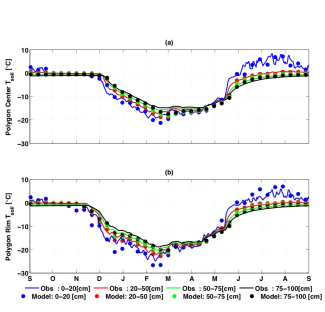We addressed two important goals of NGEE-Arctic in a recently accepted paper (Bisht et al., 2017): (1) using the MODEX concept to improve the E3SM Land Model (ELM) for high-latitude systems and (2) investigating the role of fine-scale spatial heterogeneity on landscape-scale dynamics. We extended ELM by allowing for incoming snow redistribution and incorporating subsurface 3-dimensional lateral transport of water and energy (ELM-3D). These model improvements lay a foundation towards E3SM’s goals of watershed delineated hydrological, thermal, plant, and biogeochemical representations. We applied ELM-3D to the NGEE-Arctic BEO site, where polygonal tundra are an important landscape feature and strongly affect soil hydrological, thermal, and biogeochemical processes. ELM-3D accurately represented observed soil temperature vertical profiles in the polygon rims and centers. The spatial heterogeneity of snow depth during the winter due to snow redistribution generated surface soil temperature heterogeneity that propagated in depth and time and led to ~10 cm shallower and ~5 cm deeper active layer depths under the polygon rims and centers, respectively. Additionally, snow redistribution led to spatial heterogeneity in surface energy fluxes and soil moisture during the summer. Excluding lateral subsurface hydrologic and thermal processes led to small effects on mean states but an overestimation of spatial variability in soil moisture and soil temperature as subsurface liquid pressure and thermal gradients were artificially prevented from spatially dissipating over time. Our integration of three-dimensional subsurface hydrologic and thermal subsurface dynamics in ELM will facilitate a wide range of analyses heretofore impossible in an ESM context.
For more information, please contact:
Gautam Bisht
William Riley
wjriley@lbl.gov

